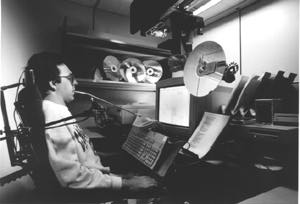1994 Project Reports | Contents | Previous | Next | Home |
The Vocational Training Facility
Interactive employment training for persons with physical disabilities
Inder Perkash, MD; Charles Burgar, MD; Machiel Van der Loos, PhD; Joy Hammel, PhD, OTR; Pam LePage, MEd; Dan Shafer, OTR; Eric Topp, MSME; David Lees, MSME; Star Teachout, MS;
Objective - The goal of the Vocational Training Facility (VTF) Merit Review Project is to develop an interactive training program to teach desktop publishing (DTP) skills to persons with spinal cord injuries in preparation for return to employment. Vocational skills are taught in a workstation setting, using adaptive access software, hardware and devices. Traditional vocational training for individuals with disabilities is hampered primarily by the difficulties of physical access to the curriculum, not the substance of the curriculum itself. The VTF has developed a self-paced curriculum, interactive video tutorials and a robot-equipped workstation to respond to the educational, vocational and daily-living needs of each student.
The goal of the VTF is to assess, train, provide an internship for, and assist in placing each student in successful employment.
Progress - The VTF Project has completed the development and integration of the DTP curriculum, a process that included assessment of commercial training materials, production of three videodiscs, and the writing of an interactive student learning and testing environment in HyperCard. We have configured and programmed three robot workstations (see Figure 1) equipped with an integrated set of low and high technology adaptive access and ergonomic technologies.
 Figure 1. This student with high-level quadriplegia commands DeVAR, the
robot assistant to insert an instructional videodisc. The VTF project produced
three videodiscs, covering areas such as desktop publishing, robot use and job
skills, as a part of the curriculum.
Figure 1. This student with high-level quadriplegia commands DeVAR, the
robot assistant to insert an instructional videodisc. The VTF project produced
three videodiscs, covering areas such as desktop publishing, robot use and job
skills, as a part of the curriculum.
Methodology - The workstations are equipped with a variety of interface devices for individualized access by disabled users. The robot performs daily-living (e.g., beverages, medication, mouthstick) and vocational support (e.g., printer output, diskettes, phone) tasks under the direction of the student. With these supports, coupled with the multimedia curriculum design, each user is able to independently learn vocational skills. The VTF Project is testing this approach in a study that compares high and low level quadriplegic students to a control group of paraplegic students.
Three students at a time undergo a 12-week, full-time training program. Conventional batteries of test instruments are supplemented by software records of user, computer, and robot events to analyze the effectiveness of the VTF concept.
Results to date - By the spring of 1994, 13 students had participated in the training and three new students were enrolled in the final round. Of the 13 who participated, 11 completed the training and passed all the competency exams; two are employed in competitive DTP-related jobs; six have or are participating in one or more advanced internships with local facilities and businesses; seven are participating in continuing education; and seven are actively searching for employment. Final results will be analyzed and reported. The VTF staff is also exploring transfer of the VTF workstation, curriculum and vocational training program model to outside facilities, businesses, education programs and VA clinics.
Republished from the 1994 Rehabilitation R&D Center Progress Report. For
current information about this project, contact
Machiel Van der Loos.